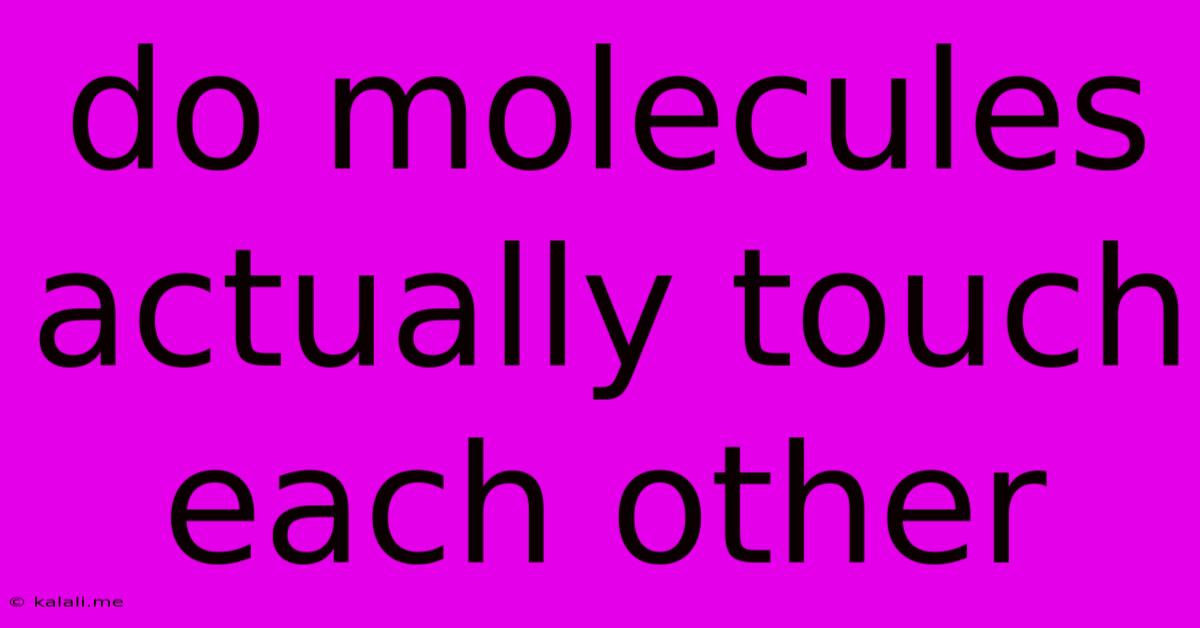Do Molecules Actually Touch Each Other
Kalali
Jun 08, 2025 · 3 min read

Table of Contents
Do Molecules Actually Touch Each Other? A Deep Dive into Intermolecular Forces
The simple answer is: no, molecules don't actually touch each other. This seemingly counterintuitive statement requires a deeper understanding of the nature of matter at the atomic and molecular level. While we visualize molecules as solid, tangible objects bumping into one another, the reality is far more nuanced and involves the fascinating world of intermolecular forces. This article will explore this concept, explaining why molecules maintain a distance and how intermolecular interactions govern their behavior.
The misconception that molecules touch stems from our macroscopic experience. We see and interact with objects that appear to be solid and in direct contact. However, at the molecular scale, the picture changes dramatically. Atoms and molecules are largely empty space, composed of a dense nucleus surrounded by a diffuse electron cloud. The seemingly solid nature of matter arises from the powerful electromagnetic forces between these electrons and nuclei.
Understanding Atomic and Molecular Structure
Atoms consist of a positively charged nucleus containing protons and neutrons, orbited by negatively charged electrons. These electrons occupy specific energy levels or orbitals, creating a three-dimensional electron cloud. Molecules, in turn, are formed by the bonding of multiple atoms through the sharing or transfer of electrons. These bonds are strong and define the molecule's structure. However, the space between molecules is significant.
The Role of Intermolecular Forces
Instead of directly touching, molecules interact through a variety of intermolecular forces. These forces are weaker than the intramolecular bonds holding atoms together within a molecule, but they are crucial for determining the physical properties of substances like boiling point, melting point, viscosity, and solubility. Some key intermolecular forces include:
-
Van der Waals forces: These are weak, short-range forces arising from temporary fluctuations in electron distribution around atoms and molecules. They include London dispersion forces, which are present in all molecules, and dipole-dipole forces, found in polar molecules. These forces are responsible for the attraction between non-polar molecules.
-
Hydrogen bonding: A special type of dipole-dipole interaction involving hydrogen atoms bonded to highly electronegative atoms like oxygen, nitrogen, or fluorine. Hydrogen bonds are relatively strong compared to other van der Waals forces and are crucial for the properties of water and many biological molecules.
-
Ionic interactions: These occur between ions, charged atoms or molecules. The electrostatic attraction between oppositely charged ions is a strong intermolecular force.
The Concept of Electron Clouds and Repulsion
The reason molecules don't touch is related to the repulsive forces between their electron clouds. As molecules approach each other, their electron clouds begin to overlap. This overlap leads to electrostatic repulsion between the negatively charged electrons, preventing the nuclei from getting too close. The optimal distance between molecules is determined by a balance between the attractive intermolecular forces and the repulsive forces between electron clouds. This distance is known as the van der Waals radius.
Implications and Further Exploration
The understanding that molecules don't physically touch has profound implications across various scientific fields, including chemistry, physics, and materials science. This knowledge helps explain the behavior of liquids, gases, and solids, as well as the properties of different materials.
Further exploration of this topic involves studying the intricacies of different intermolecular forces, exploring how these forces vary with molecular structure, and investigating the advanced techniques used to visualize and study molecular interactions, such as spectroscopy and computational modeling. Understanding the non-contact nature of molecular interactions is a cornerstone of modern chemistry and our understanding of the physical world.
Latest Posts
Latest Posts
-
How To Change A Bulb In A Recessed Light
Jun 08, 2025
-
Can You Slow Cook Meat From Frozen
Jun 08, 2025
-
Pokemon Black 2 And White 2 Exclusives
Jun 08, 2025
-
Is There A Difference Between Se And Le Spanish
Jun 08, 2025
-
Why Does My Xbox Controller Keep Disconnecting From My Pc
Jun 08, 2025
Related Post
Thank you for visiting our website which covers about Do Molecules Actually Touch Each Other . We hope the information provided has been useful to you. Feel free to contact us if you have any questions or need further assistance. See you next time and don't miss to bookmark.